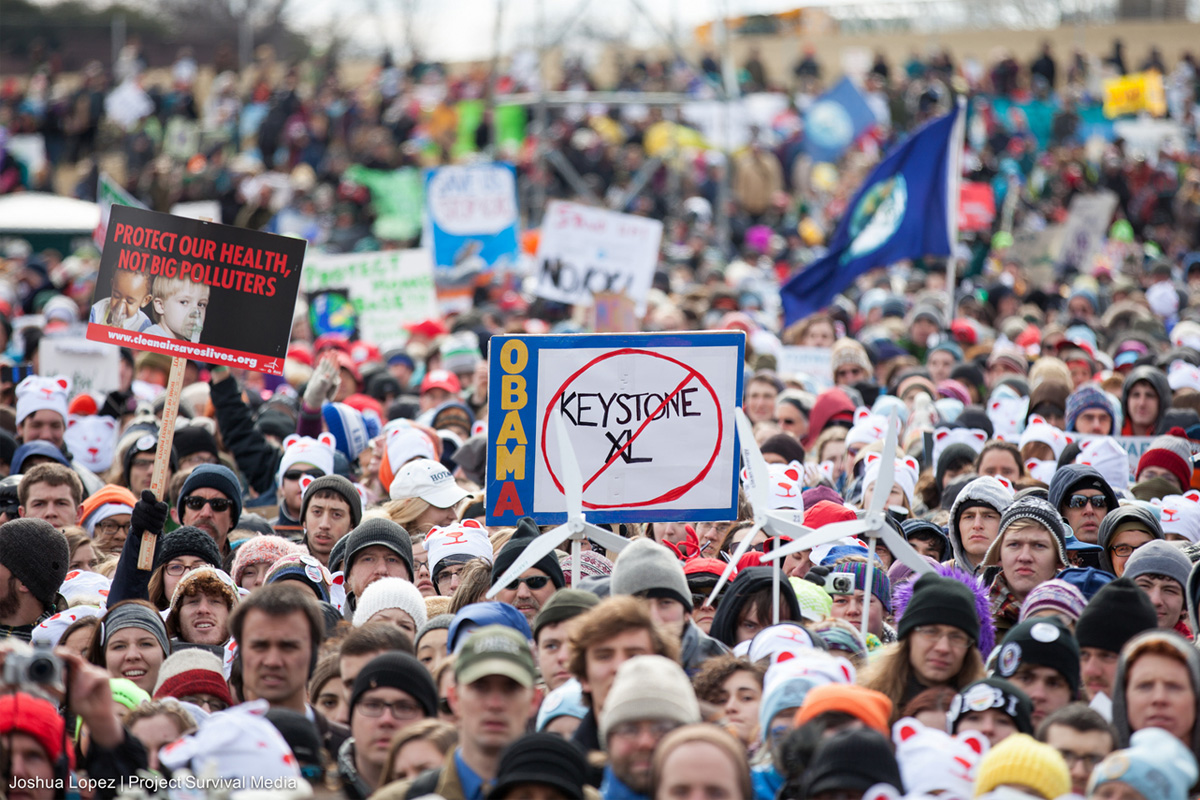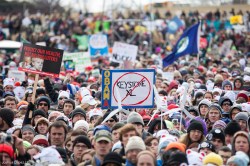What should the climate movement do next, after Keystone? Last week I approached the question through the lens of supply-side vs. demand-side fights: Should activists protest against mines, pipelines, ports, and other means through which fossil fuels reach consumers, or should they focus on reducing demand for those fuels?
Now I want to approach the same question through another lens, which is related but not quite the same: Should activists focus on fighting the negative or promoting the positive? Or put another way, on dismantling our dirty stautus-quo systems or building up sustainable new ones?
Climate change is not like the problems that have occupied the environmental movement since its heyday in the ’60s and ’70s. Those typically involved local pollutants; the solution was to modify some class of industrial widget, e.g., stick a scrubber on a coal plant.
Carbon pollution is different. It’s not a marginal byproduct of industrialization; it is an intrinsic feature of economies based on fossil fuels. Fossil fuels are made of carbon. There aren’t enough scrubbers in the world to solve climate change at the widget level. Climate change calls for new systems.
Addressing climate change is at least as much about designing and building a new world as it is about battling and dismantling the status quo. It is creation and destruction, yin and yang.
One critique of the climate movement (and the Keystone campaign) has been that yin and yang are out of balance, that there is too much focus on the negative. What are we to make of this critique?
Looking to the bright green future
I do think it’s true that, as a matter of zeitgeist, the creative, forward-looking side of the climate effort gets too little attention. Climate change concern is seen as part of a broader environmental attack on the status quo — against coal, against oil, against fracking, against big cars, against hamburgers, against plastic bags, against suburbs and strip malls, against most of the stuff that most people consume or do most of the time.
It’s a shame. There is an enormous amount of generative work to do designing and building sustainable systems, not only technological systems around power, transportation, food, and water, but economic and social systems as well. Every different kind of talent and aspiration can find a role to play. We need all the ingenuity, passion, and courage we can get.
But that narrative of a great call to arms, of potential heroism, of imagination and opportunity, of social and economic vibrancy, of rebirth, never reaches the average citizen. To her, climate change means no to this and no to that, stop this, stop that, fight this rapacious corporation, fight that rapacious corporation.
I’d like climate hawks to talk more about creating a new world. I want the public to be pulled in by the possibilities of a future that makes sense, not just terrified by the risks and dangers of the senseless present. For one thing, the generative side is important in its own right. For another, it’s more popular! Clean energy polls well. Innovation polls well. Cool new technology polls well. New industries and jobs poll well. The public is naturally inclined to support stuff like this — though that doesn’t mean it’s easy to implement.
The role of activism
So right now, the destructive and generative sides are out of balance. But that’s not to say that there isn’t a great deal to fight; struggle is essential. Just because the overall climate effort needs both creative and destructive elements doesn’t mean that all individual climate efforts must focus equally on both sides. There is such a thing as division of labor. Most of the real generative work is going to be done by designers and engineers, storytellers and futurists, researchers and entrepreneurs. Maybe on-the-street activists can still be most effective on the destructive side. As George Monbiot writes today:
Without public protest, democracy is dead. Every successful challenge to excessive power begins outside the political chamber. When protest stops, politics sclerotises: it becomes a conversation between different factions of the elite.
And here’s a related quote, from a gorgeous piece Garance Franke-Ruta wrote on ACT UP, the AIDS fight, and the new documentary How to Survive a Plague:
ACT UP worked because America worked. I’m not sure we expected that, even as we hoped for it. It taught me that everything that is marginal and powerful in American life eventually becomes central, part of the great churning from edges to mainstream that is one of the most underheralded but deep-seated patterns of our politics. That politicians only ratify social changes that start elsewhere, while true leadership comes from the grassroots, and the people. And that whoever has the most energy in any political battle usually wins. ACT UP was a fireball of energy.
Right. Impassioned grassroots activism has a storied and central role in American life.
But climate change isn’t like AIDS; Americans are not wasting away and dying before our eyes. Finding something that serves as a spark for impassioned climate activism is incredibly difficult. It is even more difficult to find something positive and generative to rally behind. Most organizers won’t say it publicly, but it’s just easier to get people fired up through outrage and anger. The great activist movements of the past were protests, and protests generally benefit from villains.
Think of it this way. Would you march in the streets on behalf of a research park? Or a new graduate program in sustainable systems design? A solar farm owned and operated by a profit-making business? A PACE financing bill? Federal cleantech funding is set to fall off a cliff over the next few years. Could a rally to support increased cleantech funding bring more than 40,000 people to the National Mall on a freezing cold day?
Color me skeptical. It may not be impossible to find positive projects or legislation that could spark activism, and benefit from it. But it’s a lot harder than critics of the climate movement (and the Keystone campaign) seem to acknowledge. Remember in 2010, when 350.org organized a whole mess of mini-rallies across the country, meant to highlight positive local solutions to climate change? I don’t remember the Keystone scolds doing much to celebrate those rallies, or the rallies having much lasting effect. It’s hard! (I’d love to hear your ideas on other positive projects amenable to organizing and activism.)
Let’s all do more to elevate the voices and profiles of the researchers, entrepreneurs, innovators, artists, organizers, and policymakers who are working to create a future that makes sense. Let’s make it clear that getting humanity through the third industrial revolution calls not merely for sacrifice and struggle but for investigation and innovation, risk-taking and money-making. Let’s make sure the best young minds of the next generation are drawn in by a chance to be part of the great work of our time, and to find greatness within it.
But let’s not expect climate activists to be all things to all people. Activism is protest, a moral call to arms against great evil. It says “stop, no more, not in our names.” The work of designing and creating, of worldchanging, is complementary to but distinct from protest. If that work lacks champions, then by all means, champion it. (And if you are involved in green philanthropy, support those who champion it.) But let activists be activists.





